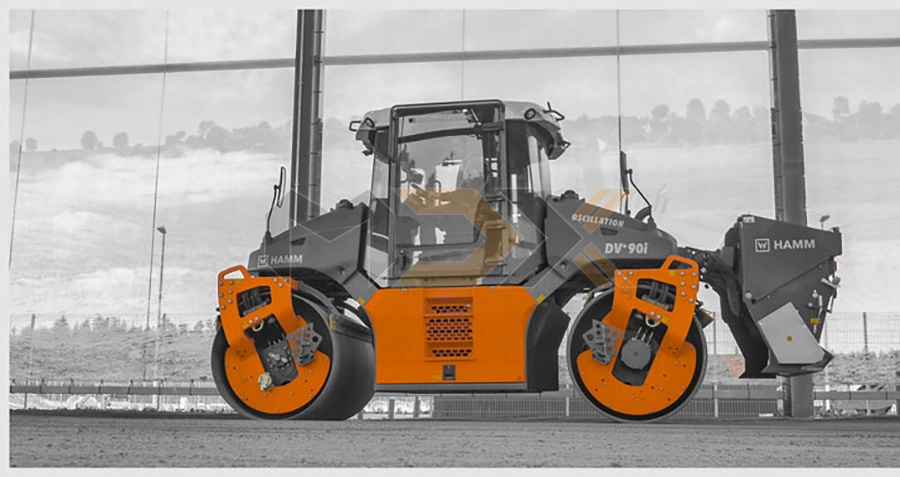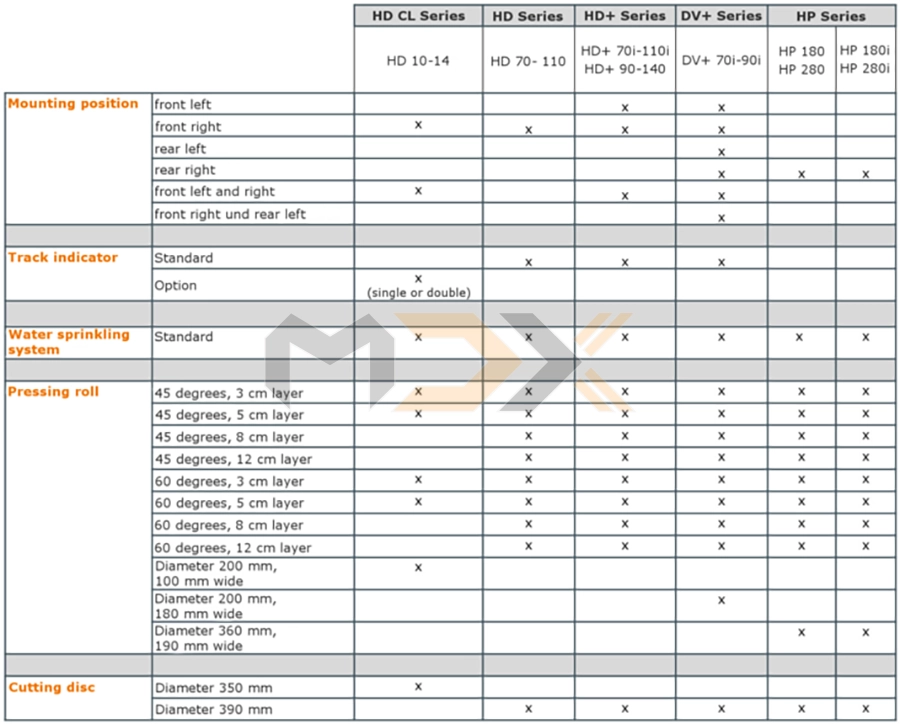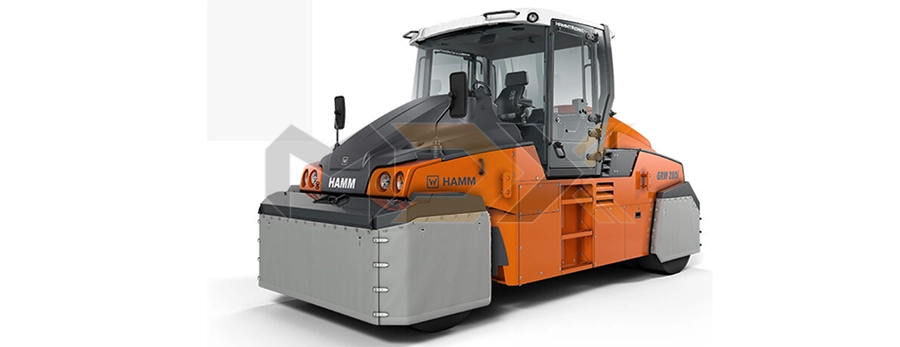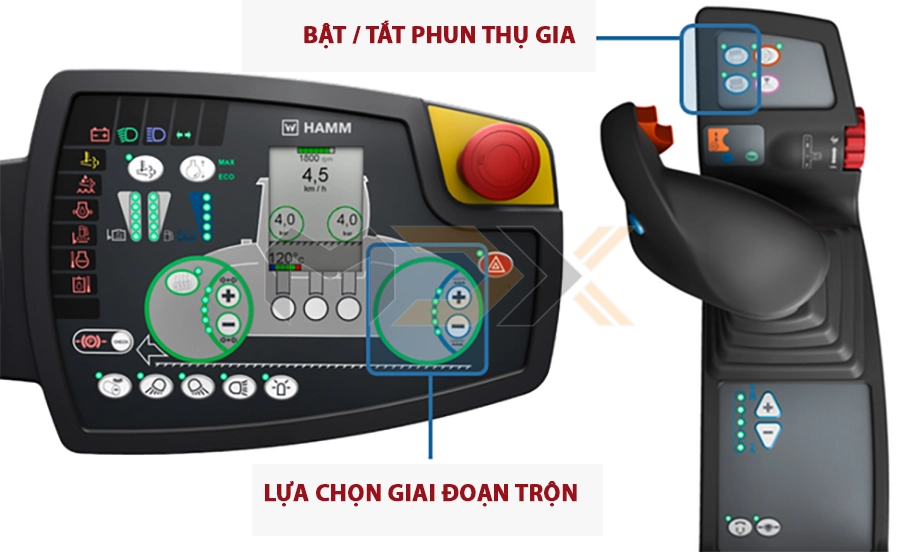THE MOST IMPORTANT OPTIONS FOR HAMM ROLLER AND THEIR APPLICATION - 2020
Hamm offer a wide range of options for our different machine types. They will take a closer look at the most important options: chip spreader, edge pressing and cutting device, frequency controller, padfoot shells, dozer blade, vibration plate, thermal aprons, tyre inflation system, additive sprinkling system.

THE MOST IMPORTANT OPTIONS AND THEIR APPLICATION - 2020

1. CHIP SPREADER

The chip spreader is an optional device for metered spreading of chips with simultaneous rolling into the road surface.
- Disc spreader
- Line spreader (electronically controlled)
The purpose is to blunt asphalt surfaces in order to improve the initial grip: Application in asphalt construction work
Application in asphalt construction work

- Surface temperature during spreading at least 100°C -> adhesion of the chips to the surface
- Optimum roller speed < 5 km/h
- No dynamic compaction during use of the chip spreader
- Typical grain sizes of the chips are 1/3 mm or 3/5 mm
Disc spreader

Spreading width very much wider than the drum width of the machine. No speed-dependent spreading of the chips. Very suitable e.g. for new motorway construction. Asymmetric spreading pattern possible, e.g. with traffic on the adjacent lane (inner-city roads)
Line spreader (electronically controlled)

Uniform spreading pattern & universal application
- Precise metering
- Spreading width = drum width of the machine
Precise driving necessary to avoid overlapping of several adjacent spreading lanes. Generally speed-dependent spreading of the chips
Chip spreaders and their application - HAMM Line Spreader (HLS)

Hamm now offers a new line spreader for the DV+ and HD CompactLine Series. This can be optionally equipped with a lift function (DV+ Series only). Further benefits:
- Manual spreading width setting via slide controller
- Rapid emptying
- New interface: Bracket on the tank can be removed
- Speed-dependent control of the chip spreading
- Tarpaulin included in standard scope of supply

HLS 100 (HD 10-12) and HLS 120 (HD 13-14), Spreading width: 1.00 m - 1.20 m

HLS 150 (DV+ 70i) and HLS 170 (DV+ 90i), 790 l – Spreading width 1.50 m, 960 l – Spreading width: 1.70 m
2. EDGE PRESSING AND CUTTING DEVICE

If a longitudinal joint is to be produced or there is no border edge to the asphalt layers, we recommend that the contact surface or the edges of the asphalt layers are sloped and compacted. This is necessary to achieve a good joint quality and to prevent water, dirt and roots from penetrating the asphalt layers from the side.
Track indicator

Simplifies driving along the edge for the operator
Water sprinkling system

Prevents the bitumen from sticking to the edge pressing and cutting device and guarantees a good cut or compacted surface
Series Configuration

Application: Edge pressing of joints (when paving “hot on cold”)

Here you can see what has to be observed during application of the edge pressing device, particularly when paving “hot on cold”.
- Demands on the contact surface

- Production of the contact surface

- Mistakes during production of the contact surface I

- Mistakes during production of the contact surface II


Here you can see what has to be observed during the application of the edge cutting device. Production of the contact surface with laying mistakes
Application: Edge cutting at joints

Caution with (ZW)OPA (drainage asphalt): No compaction of the lower edge as otherwise the water cannot run off
Spraying with bitumen

Sources: babiz.biz (left), Weiro.de (right)

Production of the contact surface with laying mistakes
3. THE FREQUENCY CONTROLLER AND ITS APPLICATION

The frequency of the vibration/oscillation can be varied using a button. The system keeps the preselected frequency constant, i.e. the system compares the frequency set by the operator (setpoint) with the actual frequency (actual value) and corrects it automatic, if necessary.
The frequency controller and its application

- The frequency controller serves to individually adapt the frequency to different asphalt mixes, layer thicknesses and speeds.
- The centrifugal force of the vibration is influenced by the frequency. The higher the frequency - with the same amplitude - the higher the generated centrifugal force.
- In order to achieve an optimum quality with respect to degree of compaction and surface evenness, especially during asphalt laying, a certain impact distance of the drum should be maintained. As an orientation, an impact distance of one inch (approx. 2.5 cm) can be considered as the optimum.
- The impact distance depends on the ground travel speed and the frequency. An excessive impact distance can result in an uneven surface and a lower degree of compaction. An insufficient impact distance increases the risk of over-compaction (formation of impact depressions and particle crushing).
4. PADFOOT SHELLS AND THEIR APPLICATION

The padfoot shells enable a compactor with smooth drum to be quickly and economically converted into a compactor with padfoot drum.
They can be installed and removed again quickly and easily.The shells extend the operating range of the compactors so that they can also be used on cohesive soils as well as on all non-cohesive and sandy mixed soils.
A compactor with padfoot drum should be used for continuous compaction of cohesive soils.
With VIO machines, the use of padfoot shells is only expedient during vibration. No compaction is achieved during oscillation, and there is a risk of damaging the shells.
5. THE DOZER BLADE AND ITS APPLICATION

The characteristics of the dozer blade

- Hydraulic cylinder in the middle
- Extendable blade area (top grille, extension)
- High-visibility cross-member: Allows an unobstructed view of the dozer blade working area
- Precision control of the blade (raising and lowering) thanks to proportional valve
- Skids prevent the blade from digging into the ground
We recommend the use of a C Model from the H Series in combination with a dozer blade, as these models offer more torque.
The dozer blade in operation

The dozer blade allows the working space to be filled and compacted without a separate earthmoving equipment. It can be used with all materials and soil types. It is particularly well suited for stripping work but is also suitable for dump site operation and for ditches and light earthwork. For smaller filling work, a compactor with dozer blade eliminates the need for a caterpillar bulldozer.
VIDEO
6. THE VIBRATION PLATE AND ITS APPLICATION

Important characteristics:
- Sideways shift to the right or left by 80 cm (31.5”)
- 75 kN max. centrifugal force
- Frequency variable between 30 and 55 Hz
- Central quick-coupler
- Baseplate of wear-resistant material

Application:
- Final compaction of non-cohesive soils, such as fine-graded sands, gravels
- Surface compaction of soils with a tendency to loosen again.
- Compaction right up to the edge
- Expands the operating spectrum of the H 11i, H 13i and H 16i compactors with working weights from 11 - 16 t (24,300 - 35,300 lbs)
- Use only for forward travel
7. THERMAL APRONS

Thermal aprons form a lateral and closed-towards-the-top space round the pneumatic tyres in which the heat ascending from the asphalt is accumulated. They ensure more efficient heating and heat control of the pneumatic tyres and thus reduce the risk of mixture sticking to the tyres.
8. THE TYRE INFLATION SYSTEM AND ITS APPLICATION

The tyre inflation system allows the inflation pressure of the tyres to be increased or decreased within a given range even while driving. This changes the footprint of the tyres. The alteration of the footprint changes the compaction depth in the subsoil. A pressure control valve prevents the tyre pressure from dropping below the minimum value. The pressure is controlled quickly and conveniently from the operator’s platform. During day-to-day operation, the tyre inflation system saves time and contributes to the compaction quality.

Buttons are used to change the inflation pressure in the tyres with the current value being shown on the display. The inflation pressure can also be varied while driving.
9. ADDITIVE SPRINKLING SYSTEM

The tyres are normally sprinkled with water. Alternatively, however, they can be sprinkled with an emulsion (additive/water mixture).
- Automatic admixing
- Constant mixing ratio
- Mixing ratio 1:1, 1:2, 1:5, 1:10 and 1:20
- No danger of demixing
- Additive no longer has to be added by hand

New additive sprinkling system- automatic metering and mixing directly as required
VIDEO
Tyre heating

Application area: In cold & windy weather conditions
Advantages:
- Safe solution thanks to diesel-fired burners and indirect heating (no risk of misfiring, no gas bottles)
- Simple operation of the tyre heating system
- No limitation of the ballasting up to 28 t (61,729 lbs)
- Expansion of the application range (difficult or delicate HMA)
- Available and unrivalled worldwide in Tier 4 markets
- Uniform heating of the tyres to 60-70° (140° F - 158° F)

Simple operation of the tyre heating system
1. Button on dashboard: Simpleswitching of the heating system ON and OFF
2. Button on display: Set the tyre surface temperature
Quick-start guide: As a sticker in the cab for the operator
News Related
Tags: chip spreader, edge pressing and cutting device, frequency controller, padfoot shells, dozer blade, vibration plate, thermal aprons, tyre inflation system, additive sprinkling system, hamm roller, soil compactor, Tandem roller


